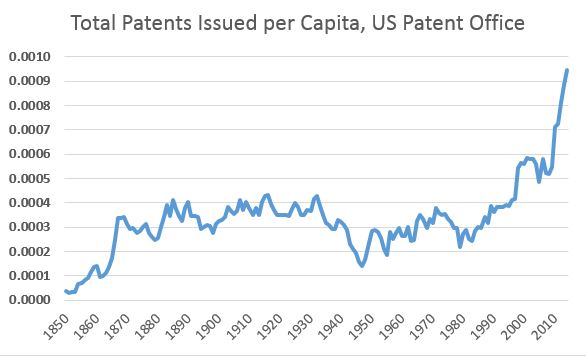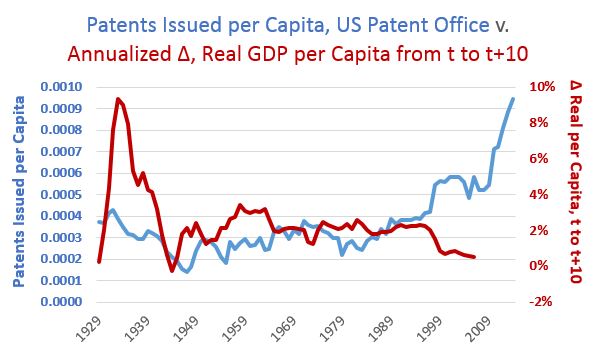Recently I discussed a paper by David Autor, David Dorn, Gordon Hanson, Gary P. Pisano and Pian Shu. The paper noted that as competition from China increased, innovation by US firms, measured by patent output, decreased. I believe the result, but started to wonder… are patents a good measure of innovation? Do patents drive economic growth? I don’t know how to measure innovation, but I can look at the relationship between patents and economic growth. We being by looking at patents per capita. I found patent data going back to 1840, and population to 1850. The graph below shows patents per capita beginning in 1850. (All data sources provided at the end of this post.) Next, let’s compare that to growth rates. We would expect patents today to lead to growth tomorrow. So, I will add a line to the graph showing, for each year, the annualized growth rate in real GDP per capita over the next ten years. That is, for 1950, the growth rate from 1950 to 1960, and for 1980, the growth rate from 1980 to 1990. Unfortunately, real GDP per capita data begins in 1929, so the original graph gets truncated. If it kind of looks to you like patents are not driving economic growth, well, it kind of looks like that to me too. In fact, if anything, the lines seem to be more negatively than positively correlated.
Topics:
Mike Kimel considers the following as important: Economic Growth, Innovation, Patents, Uncategorized
This could be interesting, too:
tom writes The Ukraine war and Europe’s deepening march of folly
Stavros Mavroudeas writes CfP of Marxist Macroeconomic Modelling workgroup – 18th WAPE Forum, Istanbul August 6-8, 2025
Lars Pålsson Syll writes The pretence-of-knowledge syndrome
Dean Baker writes Crypto and Donald Trump’s strategic baseball card reserve
Recently I discussed a paper by David Autor, David Dorn, Gordon Hanson, Gary P. Pisano and Pian Shu. The paper noted that as competition from China increased, innovation by US firms, measured by patent output, decreased. I believe the result, but started to wonder… are patents a good measure of innovation? Do patents drive economic growth?
I don’t know how to measure innovation, but I can look at the relationship between patents and economic growth. We being by looking at patents per capita. I found patent data going back to 1840, and population to 1850. The graph below shows patents per capita beginning in 1850. (All data sources provided at the end of this post.)
Next, let’s compare that to growth rates. We would expect patents today to lead to growth tomorrow. So, I will add a line to the graph showing, for each year, the annualized growth rate in real GDP per capita over the next ten years. That is, for 1950, the growth rate from 1950 to 1960, and for 1980, the growth rate from 1980 to 1990. Unfortunately, real GDP per capita data begins in 1929, so the original graph gets truncated.
If it kind of looks to you like patents are not driving economic growth, well, it kind of looks like that to me too. In fact, if anything, the lines seem to be more negatively than positively correlated. In years where there are more patents, the subsequent growth rate in real GDP for capita over a ten year period seems to go down. Conversely, fewer patents in one year seem to be associated with more growth over the next ten years.
What’s going on? Well, obviously, if there is no protection for developing intellectual capital, nobody is going to put much effort into creating that capital. On the other hand, protecting intellectual capital too well can stifle economic growth. For one, it requires spending an awful lot on on attorneys. For another, it forecloses on a lot of areas of potentially fruitful research by a lot of people who are worried about stepping into a mine field potentially defined by other people’s patents.
A few notes…
1. I have a question. Anyone have any idea why there was a big rise in patents per capita beginning in 1983? What changed? Was it some aspect of the law? Something having to do with how research was written off? What’s going on?
2. Data… Data and estimates for the US population originates with the Census, but I’m using the set cleaned up by the Texas State Library and Archives Commission since its in an easy to use format. Since data was only available decennially with no annual estimates from 1850 to 1900, I linearized the decennial to generate my own annual estimates. Real GDP per capita comes from NIPA Table 7.1. Patent data comes from the US Patent Office.
3. If you want my spreadsheet, drop me a line at my first name (mike) dot my last name (that’s kimel with one m) at gmail with a dot com.


